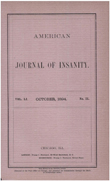Visual cortical dysfunction in Alzheimer's disease evaluated with a temporally graded "stress test" during PET
Abstract
OBJECTIVE: Visual-processing abnormalities commonly contribute to typical Alzheimer's disease symptoms, but their detailed pathophysiology remains unknown. To investigate why patients with Alzheimer's disease have greater difficulty performing visuoconstructive (magnocellular-dominated) tasks than face- or color- perception (parvocellular-dominated) tasks, the authors measured brain activation in response to a temporally graded visual stimulus (neural stress test) during positron emission tomography. METHOD: The stress test measured regional cerebral blood flow (CBF) in response to a patterned flash stimulus in the resting state (0 Hz in the dark) and at frequencies of 1, 2, 4, 7, and 14 Hz. Ten patients with Alzheimer's disease and 12 age- and sex-matched comparison subjects were studied. RESULTS: The striate response at 7 Hz and 14 Hz (the degree of regional CBF increase from that at 0 Hz) was significantly less in the patients than in the comparison subjects, whereas the change in regional CBF at the lower frequencies did not differ between groups. In bilateral middle temporal association areas activated by motion and dominated by magnocellular input, regional CBF at 1 Hz (the frequency with maximal apparent motion) was significantly greater than at 0 Hz in the comparison subjects but not in the patients. CONCLUSIONS: The magnocellular visual system normally responds to high-frequency input and motion; the failure of response in the striate cortex at high but not low frequencies in the Alzheimer's patients suggests greater magnocellular than parvocellular dysfunction at these levels. Activation failure in the middle temporal areas in the patients supports magnocellular dysfunction. The finding that the Alzheimer's disease group had abnormal visual cortical function emphasizes the importance of clinical visuospatial evaluation of patients with Alzheimer's disease to fully understand symptom production and to plan interventions.
Access content
To read the fulltext, please use one of the options below to sign in or purchase access.- Personal login
- Institutional Login
- Sign in via OpenAthens
- Register for access
-
Please login/register if you wish to pair your device and check access availability.
Not a subscriber?
PsychiatryOnline subscription options offer access to the DSM-5 library, books, journals, CME, and patient resources. This all-in-one virtual library provides psychiatrists and mental health professionals with key resources for diagnosis, treatment, research, and professional development.
Need more help? PsychiatryOnline Customer Service may be reached by emailing [email protected] or by calling 800-368-5777 (in the U.S.) or 703-907-7322 (outside the U.S.).



